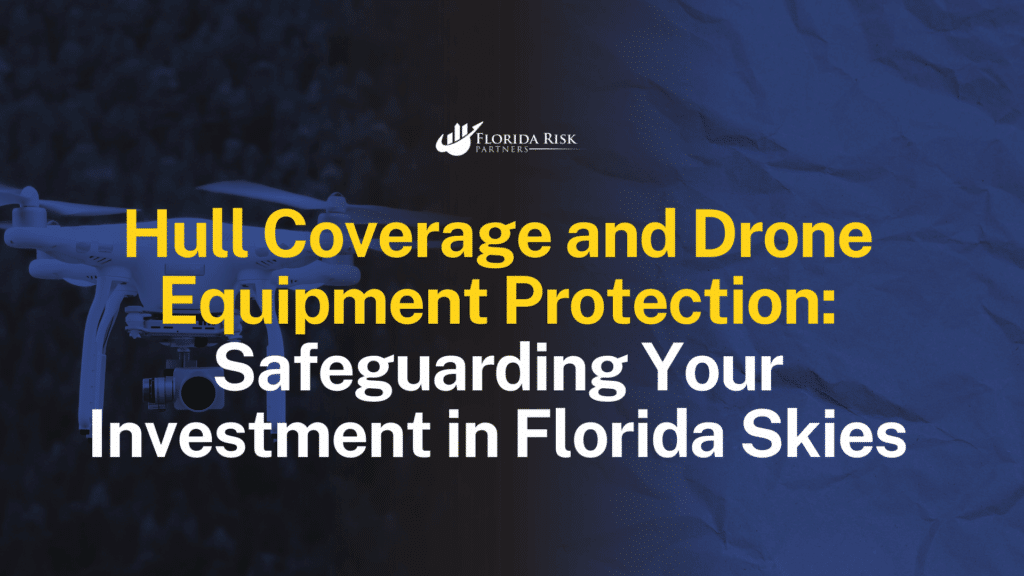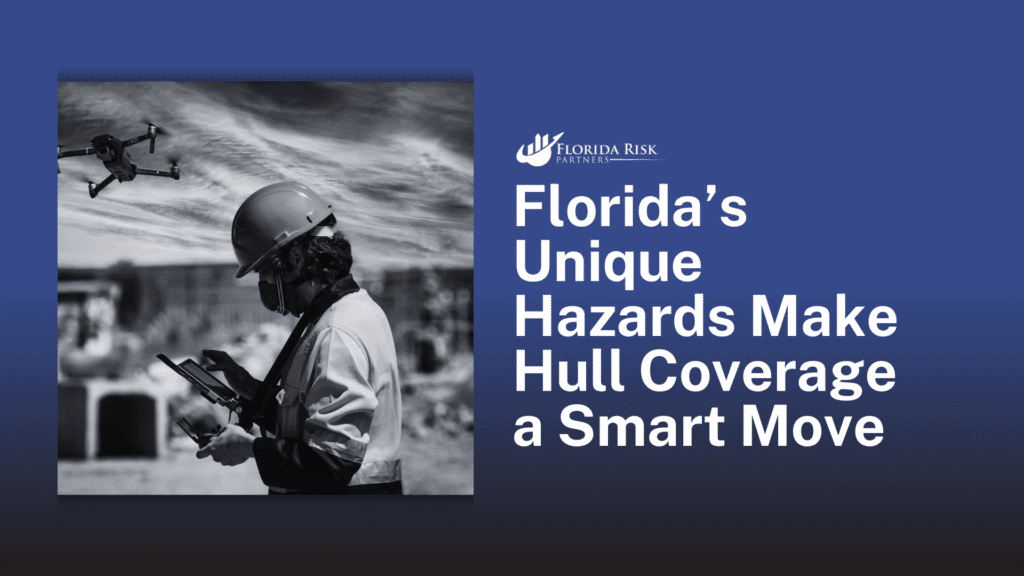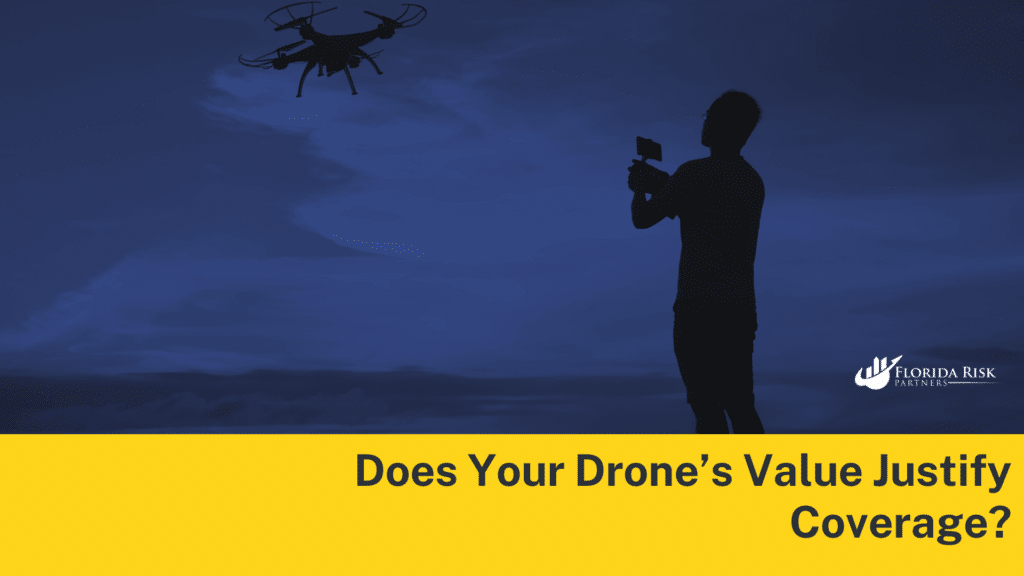-
Main Office: 1434 E. Bloomingdale Ave Valrico, FL 33596-6110
-
Phone: (888) 601-6660
-
Email: info@floridariskpartners.com

When most people think about Florida drone insurance, their minds immediately jump to liability coverage—protecting themselves in case their drone injures someone or causes property damage. And that’s understandable. Liability coverage is essential. But there’s another piece of the puzzle that far too many drone operators overlook: protecting the drone itself. If you’ve spent thousands of dollars on a high-tech flying machine and the payload it carries—whether that’s a 4K camera, infrared sensor, or multispectral imaging tool—what happens if it crashes, gets damaged by Florida’s unpredictable weather, or worse, disappears entirely? That’s where hull coverage and drone equipment protection come into play.
In this post, we’re diving deep into the importance of hull insurance for drones operating in Florida. We’ll break down what hull coverage is, what it typically includes, how Florida’s unique conditions affect your risk, and why drone equipment insurance in Florida isn’t just a good idea—it’s a vital part of your overall risk management strategy.
What Is Hull Coverage in Drone Insurance?
Think of hull insurance as the drone world’s version of comprehensive and collision auto coverage. It protects your drone against physical damage. Whether your drone hits a tree, crashes into a building, gets caught in a Florida thunderstorm, or just malfunctions and nosedives into the Gulf of Mexico, hull coverage is what helps you recover financially.
Unlike liability insurance, which protects you from third-party claims (people or property you might harm), hull coverage is first-party coverage. Hull insurance pays the policyholder for drone repairs or replacement, often including attached payloads. For commercial and high-end recreational drones, hull coverage prevents equipment losses from becoming business-ending disasters.
A standard Florida drone insurance policy with hull coverage will typically include:
- Coverage for accidental damage
- Coverage for theft, loss, or total destruction
- Optional payload protection (camera equipment, sensors, thermal imagers, etc.)
- Optional ground equipment coverage (remote controllers, base stations, tablets, etc.)
- Coverage for in-transit damage (when the drone is being moved to a site)
Some policies also offer “agreed value” coverage, meaning you and the insurer agree upfront on what the drone is worth—so if it’s totaled, you don’t have to fight over depreciation. This is especially important in Florida, where harsh conditions can accelerate equipment wear.
Florida’s Unique Hazards Make Hull Coverage a Smart Move
If you’ve operated a drone anywhere in Florida, you know this isn’t exactly the most forgiving environment. Yes, we have endless sunny skies—but we also have salt air, high humidity, sudden gusts, unpredictable thunderstorms, and a five-month-long hurricane season. These conditions don’t just pose risks to people and property; they’re brutal on drone hardware.
Weather-Driven Damage
Florida is known as the lightning capital of the U.S. We also experience regular pop-up storms during the hot season that can sneak up fast. A beautiful blue-sky day can turn into a dangerous downpour in minutes. If you’re flying a drone when one of these storms rolls in, the chance of losing your drone to wind shear, rain damage, or signal loss is real—and high.
Without hull coverage for drones, a weather-related crash means you’re replacing that drone on your own dime. Worse, if your payload—say, a $5,000 LIDAR sensor—goes down with it, your losses multiply. Having the right coverage means you can recoup those costs and get back in the air quickly.

Environmental Exposure
Then there’s the salt air and humidity. Flying near Florida’s coast exposes drones to salt and moisture, which can damage internal components. Even careful storage cannot prevent humid launch sites or salty breezes from harming gimbals, lenses, or circuit boards.
These aren’t theoretical risks—they happen all the time, especially to commercial operators who fly frequently. And while liability insurance might cover you if your failing motor causes a crash that hurts someone, it won’t cover your own drone’s internal damage. That’s where equipment protection and Florida hull insurance for drones become essential.
Wildlife and Flight Hazards
Believe it or not, Florida’s wildlife has also been known to take down drones. Seagulls, hawks, and even ospreys have been filmed attacking UAVs mid-flight. In the Everglades and other protected areas, birds can be especially aggressive toward perceived intruders. If a raptor strikes your drone and it crashes, the damage is on you—unless you have hull coverage in place.
And let’s not forget human hazards. Theft of drone equipment is rising across the country, and Florida is no exception. Left unattended at a job site or even swiped from a vehicle, drones and payloads are easy targets for theft. Fortunately, many hull insurance policies in Florida offer add-on coverage for theft or disappearance, giving you a safety net for these unfortunate but common incidents.
What’s Included in Drone Equipment Protection?
Beyond the basic hull (airframe) protection, you can customize your insurance to include coverage for everything that makes your drone operation possible. This includes:
Payload Insurance
If you’re flying commercially, chances are your drone is carrying more than just a GoPro. Cameras, multispectral sensors, LIDAR systems, crop spraying modules, and thermal imaging payloads are expensive investments that require coverage of their own. Most Florida drone equipment insurance providers will allow you to add payload coverage, either as part of your hull insurance or as a rider.
This means that if your drone goes down and the camera is destroyed, you’re not just covered for the $1,500 drone body—you’re also covered for the $8,000 sensor attached to it. This is especially important in industries like agriculture, construction, and real estate, where specialty gear is essential.
Ground Equipment Insurance
While it’s easy to focus only on what’s in the sky, a lot of drone tech stays on the ground. Transmitters, tablets, FPV goggles, laptops, and base stations are all critical to your operation—and all vulnerable to damage, theft, or malfunction. Ground equipment insurance offers protection for these tools, ensuring that a drop, spill, or theft doesn’t derail your entire operation.
In-Transit Damage
Florida drone operators often drive long distances to get to flight locations. Whether you’re heading to a citrus grove in Central Florida, a real estate shoot in Naples, or a coastal inspection job in the Panhandle, your equipment is spending a lot of time in transit. All it takes is one hard stop, a fender bender, or an improperly secured Pelican case for thousands of dollars in equipment to be compromised.
Some hull and equipment policies include in-transit coverage, which means your gear is protected even while you’re on the move. This can be especially useful for mobile operations or drone service providers working across multiple counties or states.
Does Your Drone’s Value Justify Coverage?

One of the most common questions drone pilots ask is: “Is hull insurance worth it for my drone?” The answer comes down to value and use. If you’re flying a $300 recreational drone for fun and wouldn’t be too upset if it crashed, then maybe not. But if your drone setup—body, payload, and accessories—costs $1,500 or more, it’s definitely worth considering.
Here’s a basic formula to keep in mind:
If the cost of replacement would significantly impact your finances or delay your business, you need hull insurance.
It’s also important to remember that most drone insurance in Florida is customizable. You can choose your coverage limits, deductible, and whether or not to include payloads, ground gear, or theft. The premiums are typically proportional to the value of the equipment. For example, if your drone is valued at $10,000, your annual premium for hull coverage might range between $400–$1,000 depending on other variables like location, flight hours, and pilot experience.
How Hull Coverage and Liability Work Together
Some drone operators mistakenly assume they need to choose between liability insurance and equipment coverage. The truth is, the best protection comes from combining the two.
Liability insurance covers what your drone does to others—injuries, property damage, or even personal injury (like violating someone’s privacy). Hull insurance covers what happens to your drone and equipment. Together, they create a comprehensive shield that protects you from the two biggest financial risks in drone operation: third-party claims and first-party losses.
And here’s a critical point specific to Florida: certain municipalities, event organizers, or corporate clients will require proof of both liability and equipment coverage before you can operate on-site. This is especially common in real estate, tourism, sports, and government contracting. Having a policy that includes both can help you secure more business and establish credibility as a professional.
What Happens If You Don’t Have Hull Insurance?
Let’s be blunt—without hull coverage, you’re gambling every time your drone takes off. And in Florida, that gamble can be even riskier.
Let’s say you’re inspecting a beachfront condo in Fort Lauderdale and your drone gets taken out by a sudden wind gust. It crashes onto the concrete patio three stories down. Not only is your drone totaled, but your camera is destroyed, and now your business is out a key piece of equipment. Without insurance, you’re replacing everything out-of-pocket. That might mean dipping into savings, delaying other business investments, or even pausing operations while you regroup.
Or maybe your drone falls into the Atlantic during a resort marketing shoot in the Keys. It’s unrecoverable. No insurance? That’s a complete loss.
By contrast, with a solid hull and equipment insurance policy in Florida, you simply file a claim, submit your proof, and get compensated for your loss. Within days, you can be back in the air and back in business.
Protecting the Tools That Power Your Flight
Your drone is more than a gadget—it’s your eyes in the sky, your professional edge, and in many cases, your livelihood. Protecting it should be as important as protecting your business or yourself. With Florida’s unique risks—coastal exposure, harsh weather, heavy air traffic, and widespread drone use—the argument for drone hull and equipment coverage is stronger than ever.
Ultimately, Florida drone insurance isn’t just about complying with regulations or checking a box. It’s about planning for the unexpected, being a responsible operator, and preserving your financial stability no matter what the skies bring.
Next week, we’ll take a closer look at privacy risks and how drone operators in Florida can protect themselves from costly personal injury claims. Until then, fly safe—and fly insured.
Call Us Or
Schedule an Appointment
Select an agent below to view our online calendars and select a day and time that works best for you or call us directly at 888-601-6660. When you use our online calendars, you will receive an email with more information.



